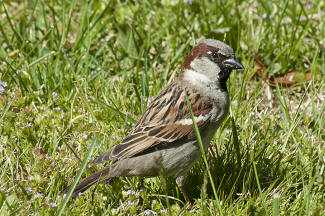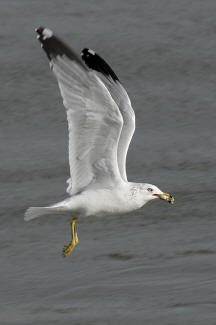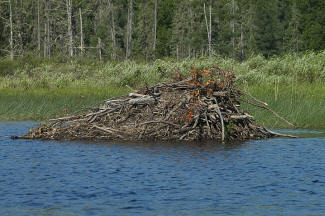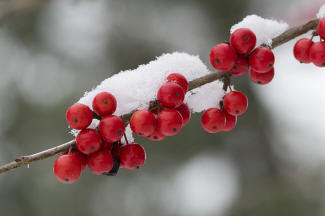PROFILES IN NATURE
English Sparrow
Photo Credit – www.kentuckyupclose.com
It doesn’t matter if one lives in the country or the city, all of
our readers should be familiar with the English Sparrow, Passer
domesticus. Another common
name is House Sparrow.
Generally considered a pest or nuisance, this sparrow is one of
the most commonly encountered birds in North America. Not a naturally
occurring species in America the English sparrow was introduced in the
1850’s. Reported reasons for these releases vary but some listed are for
insect control, or just to have a bird more familiar to European
immigrants. If insect control was a reason it is doubtful the program
was very successful because although these sparrows eat some insects the
majority of their diet consist of seeds and grains.
Shown here is the male with his distinctive black throat and
gray/brown head crest. Juveniles and females are mostly brown and ten
and can be difficult to distinguish from other sparrow species.
English sparrows prefer to build nest inside some object. This
can include holes in banks or cliffs, hollow trees, behind loose bark,
or more commonly in eves of houses and outbuildings and nesting boxes
placed for other species. Usually there are from four to five eggs in a
clutch and these birds may raise two to four broods per year.
Eggs hatch in eleven to fourteen days and the young are ready to
leave the nest in around two weeks.
Not only is the English sparrow considered a pest due to eating
farm grains and their nesting habits, but their huge numbers have
displaced many of our more desirable native songbirds.
In old England sparrows were considered a delicacy and nesting
pots were hung so as to harvest young birds for food. Seems like it
would take several though as their size is much smaller than a Cornish
hen!
By Jack
Glisson
Published in The Ballard County Weekly 01/07/2015
PROFILES IN NATURE
Ring-billed Gull
Photo Credit – www.kentuckyupclose.com
The Ring-billed Gull, scientific name
Larus delawarensis, is a
common site in all parts of Western Kentucky throughout winter. Although
we are officially listed on their migratory route large numbers seem to
winter here for the abundant food supply offered by the Ohio, Tennessee,
Mississippi, and Cumberland Rivers. Literally thousands of these and
other gulls can be seen in winter below the dams in Marshall and
Livingston Counties. Other gulls
are present but the most common here is the ring-bill, easily identified
by a yellow bill with a black ring near the tip. Older birds have a pure
white body with gray on their back and sides whereas younger birds still
have some gray plumage present on their breast.
Nesting in the Northern United States and Canada the ring-bill
raises only one brood per year consisting of two to four young.
Sometimes two or more females will lay in the same nest so there may be
five to seven young.
The primary food source of these gulls is small fish. They will
also take a variety of insects and are opportunistic feeders on human
garbage when it presents itself. This is why they are commonly seen in
black top parking lots around grocery stores and shopping malls. They
are just waiting for someone to drop a French fry or potato chip and it
will be gone in a flash! Although open dumps are becoming a thing of the
past, when located large numbers of ring-bills may be present.
At a time when many animals are getting fewer in numbers due to
larger human populations the ring-billed gull has adapted well and seems
to prefer being around humans. I am sure this is because we are
supplying them with easy pickings with scraps of food and the churning
up of bait fish around hydroelectric dams.
by Jack
Glisson
Published in The Ballard County Weekly 01/14/2015
PROFILES IN NATURE
North American Beaver
Photo Credit – www.kentuckyupclose.com
I have noticed in the brief warm spells that have melted some
ice, some signs that beavers have been quiet active.
The North American Beaver, Castor Canadensis, is common in West
Kentucky. They are rarely seen however since they are mostly nocturnal,
or active at night. What is seen is their handiwork. Beavers are
rodents, which mean their upper and lower incisors grow constantly and
have to be worn down by gnawing. And gnaw they do! A beaver can fell a
tree eight to ten inches in diameter in no time at all. Some smaller
saplings are bitten off with one or two bites from those long incisors.
The beaver will eat the inner bark from the smaller logs and
branches and then use what is left to construct dams. These dams bay be
up to four feet tall and 50 feet wide. Once the water has backed up to
form a pond for protection the beaver may build a lodge as shown above
to live and raise young in. In this area though many times they just
burrow up into the mud bank and make their dens there. This depends
somewhat on the lay of the land and the availability of mud banks with
drop offs. Other sticks are jammed into mud at the bottom of the pond
and used for food in winter when the pond is frozen over. The beaver can
retrieve these to eat at leisure in their den and never be exposed above
the ice to predators. They are excellent swimmers and can stay submerged
for up to fifteen minutes.
Bark and twigs is not the only food that beavers consume. They
will also feed on tubers from water lilies, cattails, and if available
seem to have a fondness for apples!
Mostly monogamous beavers mate for life but may find another mate
if one is lost. They raise one litter a year producing from one to four
kits.
The life span of a beaver can be up to twenty four years and
since they have indeterminate growth, (grow continuously through their
life), can attain weights of over fifty pounds.
In the past beavers have been trapped extensively for their fur.
Not many folks pursue trapping as a viable income these days so
automobiles are their biggest enemy. That and of course when they dam
and flood areas where they are not wanted the easiest way to deter them
is to call in a trapper and have the family removed, If the dam is tore
out the beavers will usually just rebuild it overnight!
When trapping was popular many trappers lived off beaver meat.
Some American Indian tribes considered it a delicacy. It is a dark
rather rich flavored meat. And no, it doesn’t taste like chicken - it
taste similar to beef!
by Jack
Glisson
Published in The Ballard County Weekly 01/21/2015
PROFILES IN NATURE
Deciduous Holly
Photo Credit – www.kentuckyupclose.com
After doing the column on the American Holly just before
Christmas, I decided to write this week on one that occurs naturally and
is common in Western Kentucky.
The Deciduous Holly, scientific name
Ilex decidua, derives the
first part of this common name because it is a deciduous tree. This
means that it drops it leaves in the fall like most of our area trees.
The latter part of this name just probably refers to the red berries
that resemble those of the American holly. Other common names for this
tree are Possumhaw, Swamp Holly, and Meadow Holly.
A rather small tree the deciduous holly grows only from fifteen
to thirty feet tall. Sometimes they may grow in clusters. Covered with
small green leaves the berries often go un noticed until the leaves turn
yellow and then drop in late fall. These red berries are eaten by a
variety of songbirds and small mammals.
These trees are common for landscape and yard plants due to their
small size and hardiness in this zone. The light colored smooth gray
bark and the fact that the showy red berries tend to remain attached
through winter makes them attractive as border and edging plants.
Although propagated by seeds, these may take years to sprout. It
is best to look for nursery stock or at the very least commercially
prepared seeds that have undergone specific temperature regimens prior
to attempting germination. Many of the local yard trees just happened to
sprout and grow in useful areas.
With any luck at all, maybe our local trees won’t see much more
of this snow cover as pictured for the remainder of this year!
by Jack
Glisson
Published in The Ballard County Weekly 01/28/2015



